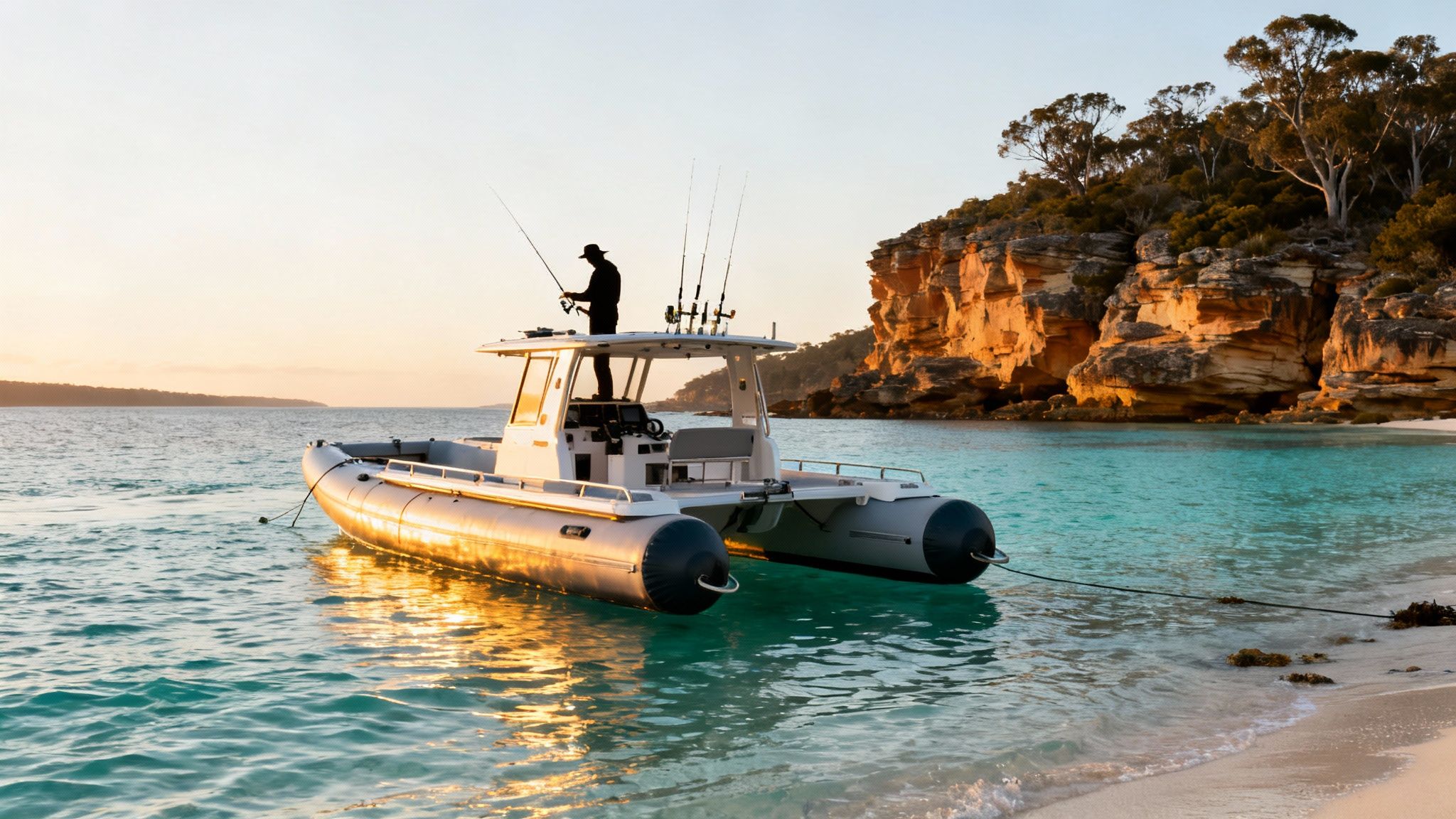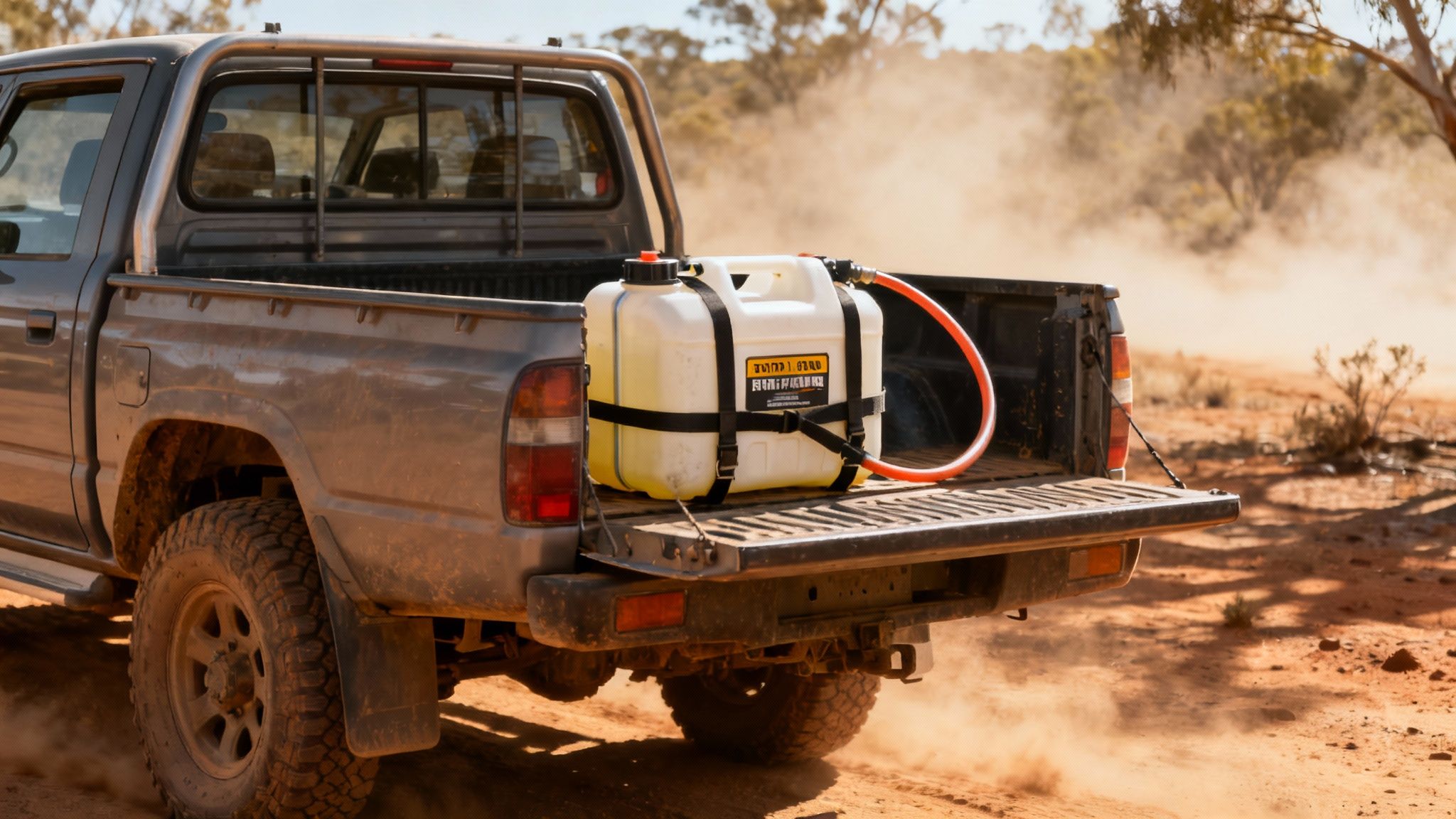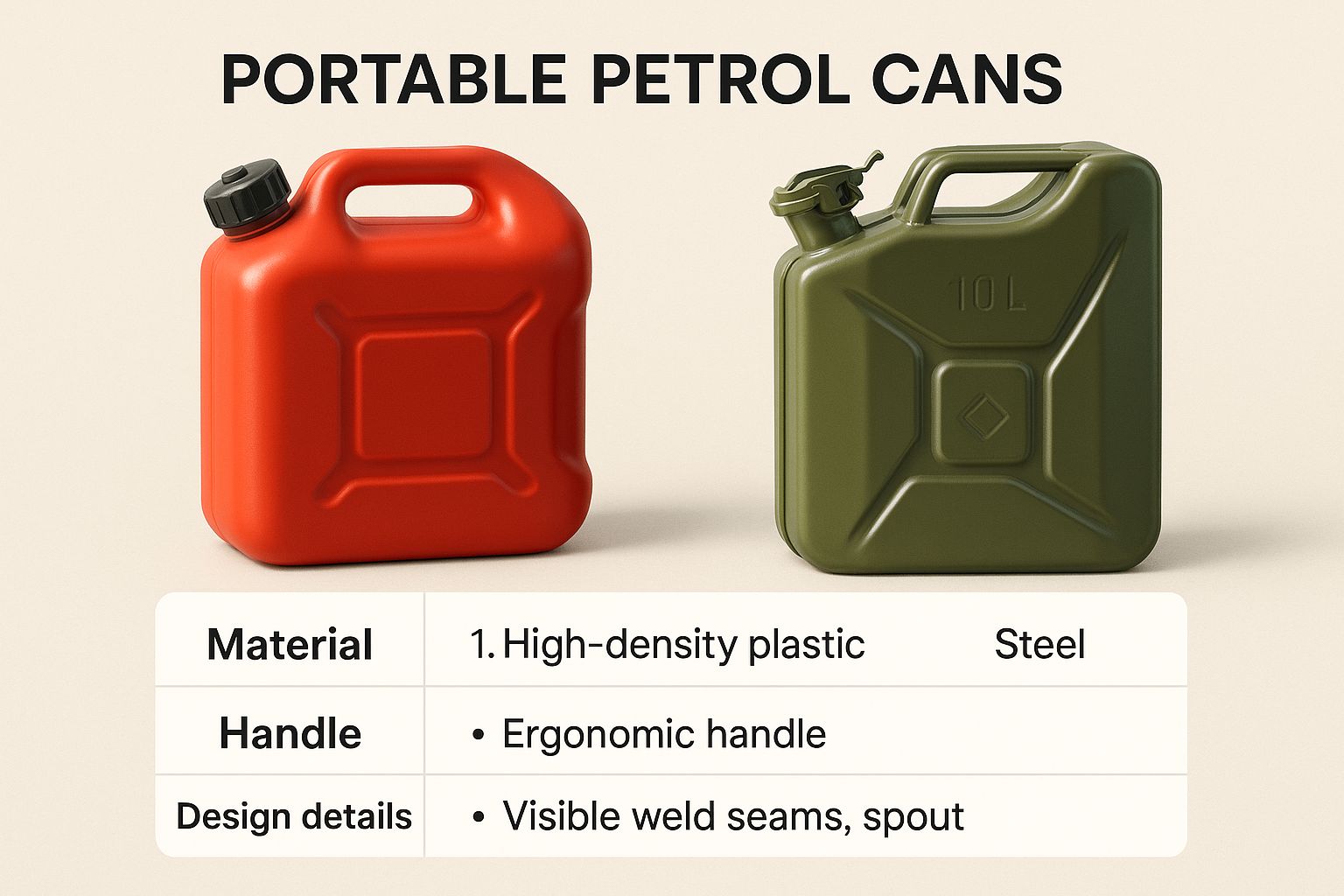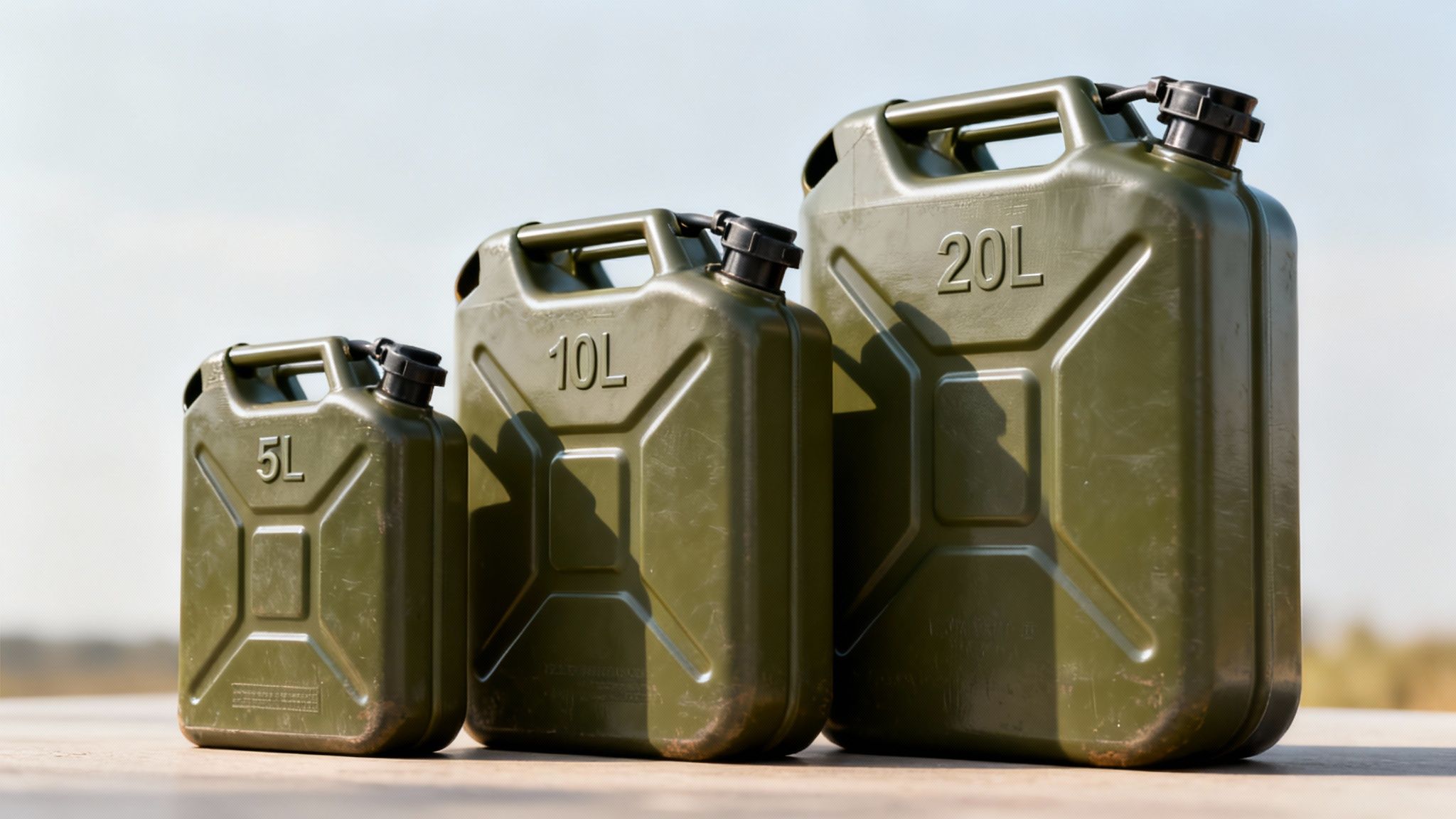
Ever found yourself stuck, miles from the nearest servo, with the fuel gauge firmly on empty? It’s a sinking feeling that can turn a great day out into a stressful ordeal. A portable petrol tank is your best insurance against getting stranded, giving you a safe, sealed container to carry extra fuel for your vehicle, boat, or outdoor power gear.
Imagine being able to extend that fishing trip, finish that last bit of yard work, or have total peace of mind on a long outback drive. That's the freedom a reliable petrol tank gives you.

Running out of fuel is more than just an annoying delay; it can completely derail your plans and even land you in a genuinely risky situation. Picture this: you're out on the bay, the fish are biting, but the fuel is low. Do you head back early or risk it? With a spare tank, you don't have to choose. Having a reliable supply of extra petrol is all about peace of mind.
Think about the real-world moments where a purpose-built tank becomes a lifesaver. It’s not just for roadside emergencies. A quality portable petrol tank is a vital tool for a huge range of activities, making life that much easier.
Consider these common situations where having that extra fuel on hand is a complete game-changer:
Simply put, a certified portable petrol tank isn't just a container; it's a tool that gives you freedom, safety, and preparedness. Grabbing any old plastic bottle or unapproved container is a serious risk.
Using the wrong container can lead to dangerous leaks, fume build-up, and even hefty fines for not meeting Australian safety standards. A purpose-built tank is engineered to handle flammable liquids safely, with features designed to prevent spills and withstand the pressures of being carted around. Investing in the right one means you can focus on the job at hand without giving fuel safety a second thought.
When you’re looking for a portable petrol tank, the biggest question usually boils down to one simple thing: material. Are you better off with a modern, lightweight plastic can, or a traditional, heavy-duty metal one? The right choice isn’t about which is better overall, but which is better for you and your specific needs.
This infographic gives you a quick side-by-side comparison, showing the key visual and material differences between a standard plastic tank and a classic steel jerry can.

You can immediately see the robust, welded construction of the metal can versus the moulded, ergonomic design of its plastic counterpart. This helps guide you toward the material that best suits your needs for handling and durability.
High-Density Polyethylene (HDPE) is the go-to material for most of the red petrol cans you see these days. Think of it as the versatile all-rounder, perfect for boaties, campers, and homeowners.
Its biggest advantage is weight. An empty plastic can is a whole lot lighter than its metal cousin, making it much easier to carry from the car to the mower or down to the boat ramp.
But don't mistake lightweight for flimsy. Modern HDPE is incredibly tough and, most importantly, it won’t rust. This makes plastic a fantastic choice for marine environments or humid climates where a steel can might start to show its age. Plastic cans also have a bit of give, meaning they can often bounce back from a minor drop that would permanently dent a metal tank. This kind of resilience is similar to the toughness found in the high-grade PVC materials used for inflatable boats. If you want to dive deeper into material toughness, you can learn more about the benefits of different advanced PVC materials.
Metal jerry cans are the undisputed heavyweights of fuel storage, built for pure toughness and a seriously long life. A well-looked-after steel can is an investment that can serve you for decades.
They are the go-to for serious off-roading, construction sites, and farm work—anywhere gear gets treated a bit rough. Their rigid construction means they are far less prone to swelling or contracting with big temperature swings, and steel offers superior protection against punctures from sharp tools or rocks.
If your portable petrol tank is going to be rattling around in the back of a ute with tools and other heavy equipment, the sheer strength of steel gives you unmatched peace of mind.
To make the decision easier, let's break down the key differences. This table puts the practical pros and cons of each material for your portable petrol tank right in front of you.
A quick-glance comparison of the key features of High-Density Polyethylene (HDPE) plastic and metal portable petrol tanks to help you choose the best option for your needs.
| Feature | HDPE Plastic Tanks | Metal (Steel/Aluminium) Tanks |
|---|---|---|
| Durability | Resists dents from minor impacts and is completely rust-proof. | Extremely puncture-resistant and can withstand heavy abuse, but can dent and rust if paint is compromised. |
| Weight | Significantly lighter and easier to carry, especially when full. | Heavier and more cumbersome, requiring more effort to transport. |
| Cost | Generally more affordable upfront, offering great value for most users. | Higher initial cost, but can offer a longer lifespan if properly maintained. |
| Best For | Homeowners, boaties, casual campers, and general emergency backup fuel. | Tradies, serious 4WD enthusiasts, farmers, and commercial worksites. |
So, what's the final verdict? It really comes down to your primary use.
For the homeowner needing fuel for the mower or a family planning a weekend boat trip, a lightweight and rust-proof HDPE plastic tank is almost always the most practical and wallet-friendly solution.
However, for the tradie whose can needs to survive a demanding worksite day after day, the rugged durability of a classic steel metal tank is well worth the extra weight and cost.

Choosing the right capacity for your portable petrol tank isn’t just about grabbing the biggest one off the shelf. It’s a balancing act. You need enough fuel for the job, but the tank also has to be practical, safe, and easy for you to actually handle.
Think of it like this: you need to refuel a small generator. A massive 20L tank is heavy and awkward, increasing your chance of a messy spill. A 5L tank is perfect. Match the tank to the task for a hassle-free day.
For most day-to-day jobs, a smaller tank is the smarter, more manageable choice. Those compact 5-litre cans are perfect for keeping your essential outdoor power equipment topped up.
The real win here is how easy they are to manage. A full 5-litre can weighs just over 5 kilograms, making it simple to lift and pour accurately, which means fewer messy and dangerous spills.
When you’re planning a serious trip or need a reliable emergency backup, the 20-litre jerry can is the undisputed king. This size is the standard for serious adventurers and anyone who needs a substantial fuel reserve on hand.
A 20-litre can is the perfect solution for:
But that extra capacity comes with a hefty trade-off. A full 20-litre can of petrol weighs around 18-20 kilograms. That's a lot of weight, and it can be a real challenge to lift and pour safely, especially into a high vehicle fuel tank, increasing the risk of spillage.
It’s important to know you can't just load your ute with as much fuel as you can fit. Australia has strict legal limits on how much petrol you can transport in portable containers.
While the rules can vary a little between states, the general guideline is that you can carry up to 250 litres in approved portable petrol tanks, as long as no single container is larger than 25 litres.
Always make sure your tanks are properly secured and sitting upright during transport. This prevents them from tipping over and leaking, and it’s not just a good idea—it’s a legal requirement. A simple set of ratchet straps can save you from a fine and a dangerous mess.
When you're dealing with something as flammable as petrol, safety isn't just a suggestion—it's everything. The rules and regulations can seem a bit much at first, but they’re actually there to keep things simple and, most importantly, keep you safe.
The single most critical thing to look for on any portable petrol tank in Australia is the AS/NZS 2906 certification. Think of this sticker not just as a label, but as a guarantee. It’s your confirmation that the tank has been put through its paces and passed rigorous tests for durability, leak prevention, and overall safety.
If a tank doesn't have this certification, it’s a massive red flag. Don't be tempted by a cheap, uncertified can at a market stall. It hasn't been proven to handle pressure changes, resist impacts, or stop dangerous vapours from leaking out. It’s just not worth the risk.
This standard is your assurance that the tank is built tough enough for the job. It's a comprehensive set of rules that cover everything from the thickness of the plastic or metal to the design of the cap.
When you buy a certified tank, you know it comes with specific features designed to prevent common accidents. These aren't just nice-to-haves; they are essential for handling fuel safely.
Key safety features you should always look for include:
A certified portable petrol tank is an engineered safety system. Every single part, from the handle to the spout, is designed to work together to contain a highly volatile substance, giving you complete peace of mind.
Owning a compliant tank is step one, but getting it from A to B safely is just as crucial. In Australia, you’re legally required to secure your portable petrol tanks during transport. An unsecured can sliding around in the back of a ute or car boot is a serious hazard waiting to happen.
To travel safely and avoid any fines, always make sure your tanks are:
This goes for your boat, too. A loose fuel tank on the water is incredibly dangerous. Making sure you have a quality, correctly fitted fuel line is non-negotiable for safe boating. For a deep dive into this critical component, check out our guide on selecting an outboard engine fuel line.
Taking these simple precautions ensures you're meeting your legal obligations and dramatically reducing the risk of a dangerous spill.
Having a certified portable petrol tank is the right start, but knowing how to handle and store it properly is what really keeps you, your family, and your gear safe. A few simple habits can turn what seems like a risky job into a routine, safe practice, making sure you get the most out of your equipment without any dramas.
Getting the filling, pouring, and storing right prevents dangerous spills, cuts down fire risk, and can even make your petrol-powered tools last longer. It’s all about building good habits that quickly become second nature.
The safety process begins the moment you pull up to the servo. It might seem tempting to leave your portable tank in the back of the ute or in the boot while you fill it, but this is a shortcut you should never, ever take.
Static electricity is the invisible danger here. A tiny spark can ignite petrol fumes, and your car’s rubber tyres act as an insulator, stopping any static charge from grounding safely. Placing the can directly on the ground completely removes this risk.
Here’s your simple, safe filling checklist:
Once you're done, screw the cap on tight and wipe off any drips before carefully putting it back in your vehicle for the trip home.
Most spills happen when you're transferring fuel from the portable tank to your car, boat, or mower. A good flexible pouring spout is your best friend for this job; it gives you far better control and cuts down on the mess. Just make sure the spout is screwed on tight and the air vent (if your can has one) is open to get a smooth, glug-free flow.
When it comes to storage, it’s all about location, location, location. The main goal is to keep your fuel can well away from your living spaces and anything that could possibly start a fire.
The best storage spot for a portable petrol tank is in a well-ventilated, separate shed or garage. Keep it out of direct sunlight and away from heat sources like hot water heaters or electrical appliances. Never, ever store petrol inside your home.
Following this single rule massively reduces your risk of a fire. If you find you need larger or more permanent fuel solutions for a boat or other equipment, it's worth exploring a range of certified external fuel tanks that offer a purpose-built and even safer way to manage bigger fuel needs.
Your fuel can itself needs a bit of looking after to stay in safe, working condition. Before you use it each time, give it a quick once-over.
It’s also important to remember that petrol has a surprisingly short shelf life. Unlike propane, which lasts for ages, petrol starts to go off after just a few months. As it oxidises, it creates gums and varnishes that are notorious for clogging up fuel lines and carburettors.
Stale fuel is one of the most common reasons why mowers, chainsaws, and outboards refuse to start. To dodge this headache, try to use any petrol you have stored within three to six months. If you know you need to keep it for longer, adding a quality fuel stabiliser when you first fill the can will extend its life and help ensure your gear starts without a fuss every time.
Choosing the right petrol tank is simple once you know what to look for. Think of this as your final pre-purchase inspection—a quick checklist that brings everything together to help you pick a high-quality, compliant tank that actually fits your needs.
First up, let’s talk construction. Is a lightweight plastic can the smart choice for weekend boating trips, or does the rugged durability of a steel tank make more sense for your worksite? Your main use for the tank will almost always point you to the right material.
Next is capacity. A compact 5-litre tank is perfect for topping up the lawnmower, but a 20-litre can gives you the range and peace of mind you need for a 4WD adventure or as an emergency backup. Just remember the trade-off: a bigger tank holds more fuel, but it’s a lot heavier and trickier to pour from safely.
Once you’ve settled on the material and capacity, your final checks should be all about safety and practical use. Before you buy any portable petrol tanks, run through these non-negotiable points:
By prioritising certified materials, matching the size to your task, and committing to safe handling habits, you're not just buying a container. You're investing in a reliable tool that delivers fuel safely and efficiently whenever you need it.
Ready to put this knowledge into practice? You're now fully equipped to choose the perfect tank.
Browse our curated range of certified portable petrol tanks and find the ideal solution for your next adventure today.
When you're dealing with portable petrol tanks, a few common questions always seem to pop up. Getting the right answers is key to handling fuel safely and with confidence. We've pulled together the most frequent queries to help you solve common problems and get the most out of your gear.
Each answer below is designed to give you straightforward, practical advice you can use right away—whether you're on the road, at the worksite, or getting ready for a weekend on the water.
It's a common myth that petrol can last forever in a jerry can. The reality is, modern unleaded fuel has a surprisingly short shelf life. When stored in a sealed, compliant portable petrol tank, you can typically expect it to stay fresh for about three to six months.
After that, it starts to oxidise and break down. This process creates gums and varnishes that are notorious for clogging fuel lines and carburettors, which can lead to poor engine performance or your equipment failing to start at all.
Need to store fuel for a bit longer? The smart move is to add a quality fuel stabiliser the moment you fill the can. A good stabiliser can extend the life of your petrol for up to a year or more, saving you the headache of dealing with stale, useless fuel.
While it might seem convenient to grab whatever can is empty, you should never store diesel or any other fuel in a container designated for petrol. In Australia, our containers are colour-coded for a critical safety reason: to stop you from accidentally misfuelling and destroying an engine.
The standard colour code is simple:
Using the right colour isn't just a suggestion; it’s a crucial safety habit that protects your vehicles and equipment from seriously expensive damage. Accidentally putting petrol in a diesel engine (or vice versa) can lead to thousands of dollars in repairs.
Seeing your plastic portable petrol tank bulge out can be pretty alarming, but it's usually not a sign that the can is faulty. This swelling is just a build-up of vapour pressure inside, which happens when the temperature climbs and the petrol expands.
Certified portable petrol tanks are actually designed to handle this. The fix is simple and safe:
This is a normal function of a properly designed fuel can, built to prevent the container from splitting under pressure. Making a habit of venting your can, especially on hot days, is a great way to stay safe.
Now that you've got the answers, you have everything you need to choose and use your fuel storage safely. Equip yourself with a reliable, certified tank that gives you total peace of mind on every trip.
At Easy Inflatables, we offer a range of high-quality, compliant portable petrol tanks perfect for any adventure. Browse our selection and find the ideal solution for your needs.
Experience the ultimate freedom on the water with our top-quality inflatable boats and accessories. Easy Inflatables is your trusted partner, providing everything you need for a safe and unforgettable adventure.
At Easy Inflatables, we believe in empowering adventurers with high-quality inflatable solutions. Our commitment to durability and performance ensures that every product enhances your outdoor experiences.